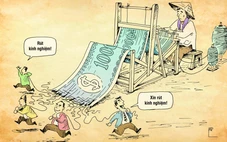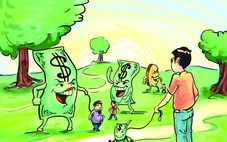 Phóng to Phóng to |
| Ha Long palm - one of the special plants of Ha Long bay. |
Ha Long bay’s bio diversity includes three factors – species classes, ecosystems and gene categories.
The place that has many floras in the Red Book of Vietnam
About species classes, according to the incomplete research, evaluations from the scientists of the Institute of marine resources and environment and Institute of resource ecosystem and biology, up to now, in Ha Long Bay, they have recognized 435 species of terrestrial floras (416 magnoliophita species, 14 polypodiophyta species, 2 Lycopodiophyta species; 1 psilopaida species; 2 Cydadaceae species), 28 species of mangrove flora, 5 species of sea-grass, 234 species of coral reef, 139 species of sea weed, 278 species of phytoplankton, 133 species of zooplankton, 315 spices of fish, 545 species of mollusk living at the sea-bed, 178 species of mollusk living on land, 17 species of fungi, 81 species of reptile, 53 species of Foraminifera, 22 species of animal living on islands, 76 species of bird, 4 species of amphibian, etc.
Among them, many rare species are listed in the Red Book of Vietnam. Especially, up to now, scientists have specified 14 rare and unique species of flora in Ha Long such as Ha Long fan palm, cycad, Ha Long fig.
About ecological diversity, scientific research works has found that Ha Long bay has a number of ecosystems typical for tropical seashore, such as, wetland ecosystem, coral reel ecosystem, tidal flats, sea-weed ecosystem, hills and mounds.
Especially, Ha Long bay also has “tung”, “ang” ecosystem which is unique and rare here. These are actually Karst lakes, wells or funnels flooded by the sea, with the enclosed form or marine notch through phreatic caves, formed by the natural erosion and weather.
The diversified landscape of Ha Long bay is a crucial natural factor to develop and conserve the bio diversity. On the other hand, bio diversity increases the distinction and attraction of the diversified landscape.
Therefore, the protection, management, and usage of bio diversity is very necessary. Its benefits were, are and will be helpful to stable environment management, economics development, and living standard raising.
However, nowadays, the bio diversity in Ha Long bay is threatened with environmental recession. The area of some tidal flats and mangrove forest is being decreased. The water products are exploited. These are brought about by human beings.
Efforts to conserve the bio diversity of Ha Long Bay
To conserve the bio diversity, some methods and principles have been applied, such as insitu conservation and ex-situ conversation.
Insitu conservation takes place on site. This is one of the conservation forms that are most applied in many countries. This is applied to all objects in need of conservation, not threatened with extinction or harm, or in the conditions that people can interfere with methods to manage and protect.
The advantages of this form of conservation are at low expense, suitable to natural living conditions of species, so it ensures their breeding and growing. Nevertheless, this form also has its disadvantages which are risks, mishaps and catastrophes made by humans can happen anytime.
Ex-situ conservation is to move the conserved objects from the locations they exist. This form is applied to the objects that are in high risks to be threatened or extinct, especially rare in the nature, or to serve the purpose of researching, displaying, introducing, etc.
With this kind of conservation, the reserved objects can be stored in gene banks, museums or moved to more appropriate positions or locations. The disadvantages are high expense, high technique and technology requirement.
However, the advantage is they make good the disadvantages of insitu conservation, such as preserving the status quo of the objects as collected and conserving to anytime in the future, avoiding the risks from the nature. Besides, this method not only increases the number of communities, objects but also avoids the risk of recession in local species and varieties.
With the bio diversity conservation in Ha Long Bay, according to the real conditions, the two methods – insitu and exsitu conservation can be applied. To the insitu conservation, first of all, the natural environment should be protected. The causes of damages or risks to the bio diversity such as effects from tourism activities, environmental pollutions, water production was exploited or endangered, should be eliminated.
Besides, investigations of the locations with high bio diversity, places with typical ecosystem to divide the area for management and protection with special condition can be carried out. Especially, on some islands, people can choose locations of groups, unique and rare species of flora, typical ecosystem, etc to localize the area to protect.
These places can be very the location for studying, researching of students and tourists. The standards to choose an area to build the garden can be based on the high density of the typical floras, various floristic compositions, and the convenience of transportation and sight-seeing, less effects from human beings, etc.
With the ex-situ, the first step can be building a botanical garden on the island. There can be Ha Long typical plants moved or added, such as Ha Long cycad, yellow slipper orchid, violet chirita, Ha Long fan palm to conserve mostly the gene sources of the floras in the conservation. Some appropriate places can be chosen to build artificial ecosystem and a number of water creatures can be cultivated and protected here.
Besides, people can collect samples and set up scientific files on some floras in the Red Book of Vietnam and the World, species that are sensitive with the changes of the environment, at the edge of extinction to store, conserve, and protect in the gene bank.
A simpler form of conservation is to multiplicate some unique and rare species to limit the risks of extinction. This ex-situ conservation will help to store the local seeds of Ha Long and limit to the minimum the effects of nature and human beings.
However, bio diversity is a closed circulation. There are tight connections, mutual effects between ecosystems. If one of the factors of the process is affected, it will influence other factors.
In the nutshell, to reserve the bio diversity in Ha Long bay, the best method is to protect the natural living environment as it exists, and to limit to the minimum the effects of nature and human beings.











Tối đa: 1500 ký tự
Hiện chưa có bình luận nào, hãy là người đầu tiên bình luận